Abstract
1. Two mutant human skeletal muscle voltage-gated Na+ channel alpha-subunits (hSkM1), with mutations found in patients with hereditary paramyotonia congenita (T1313M on the III-IV linker and R1448C on the outside of S4 of repeat IV), and wild-type hSkM1 channels were expressed in a human embryonic kidney cell lines (tsA201) using recombinant cDNA. 2. Compared with wild-type, both mutants exhibited altered inactivation phenotypes. Current decay was slowed for both, but voltage-dependent availability from inactivation was shifted in the negative direction for R1448C and in the positive direction for T1313M. 3. The hypothesis that a local anaesthetic, lidocaine (lignocaine), binds primarily to the inactivated state to block the channel was reassessed by testing lidocaine block of these two mutants and the wild-type channel. 4. T1313M showed reduced phasic block, but R1448C showed increased phasic block for trains of depolarizations. 5. Rest block (from -120 mV) was increased for R1448C (IC50 approximately equal to 0.2 mM) and decreased for T1313M (IC50 approximately equal to 1.3 mM) compared with wild-type (IC50 approximately 0.5 mM), but these differences were diminished at a holding potential of -150 mV, suggesting that the differences were caused by binding to the inactivated state rather than a different affinity of lidocaine for the resting state. 6. Inactivated state affinity measured from lidocaine-induced shifts in voltage-dependent availability was reduced for T1313M (Kd = 63 microM) but little changed for R1448C (Kd = 14 microM) compared with wild-type (Kd = 11 microM). Two pulse recovery protocols showed faster recovery from lidocaine block for T1313M and slower recovery for R1448C. Together these accounted for the opposite effects on lidocaine phasic block observed for the mutant channels. 7. Neither mutation is located at a putative lidocaine binding site in domain 4 S6, yet both affected lidocaine block. The data suggest that R1448C altered phasic lidocaine block mainly through altered kinetics, but T1313M altered block through a change in affinity for the inactivated state. These findings have implications for drug therapy of paramyotonia congenita, and also provide an insight into structural requirements for drug affinity.
Full text
PDF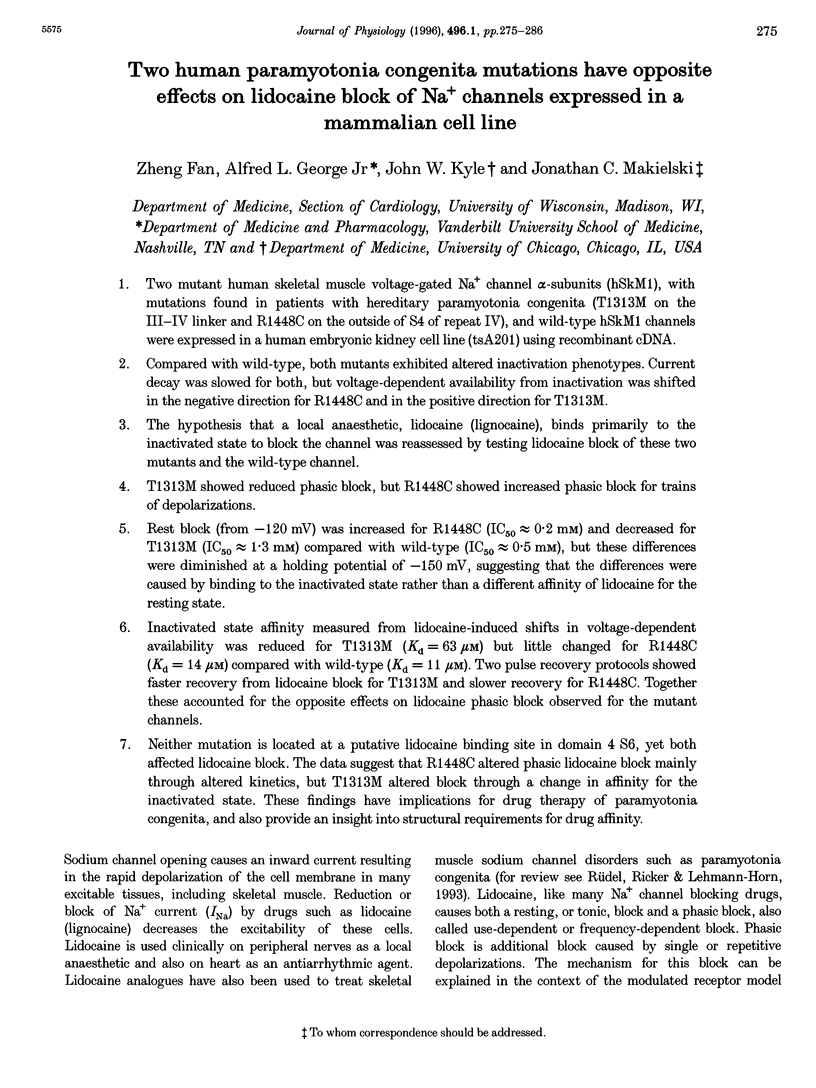
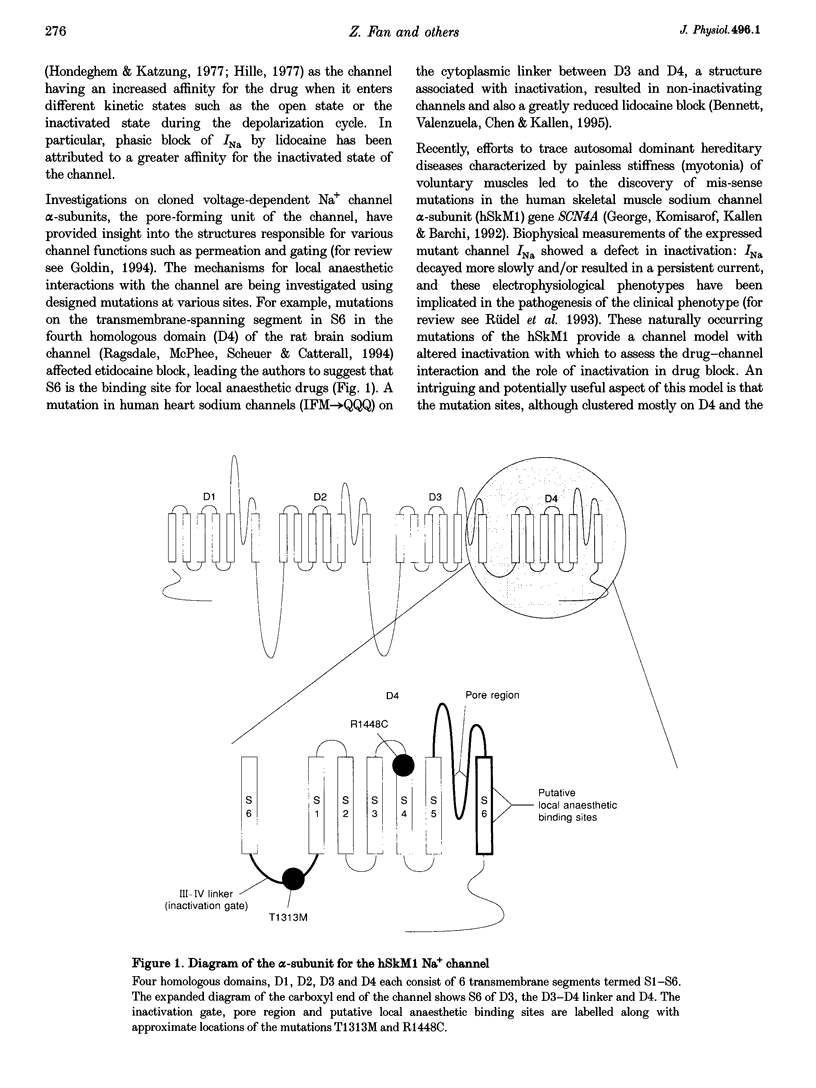
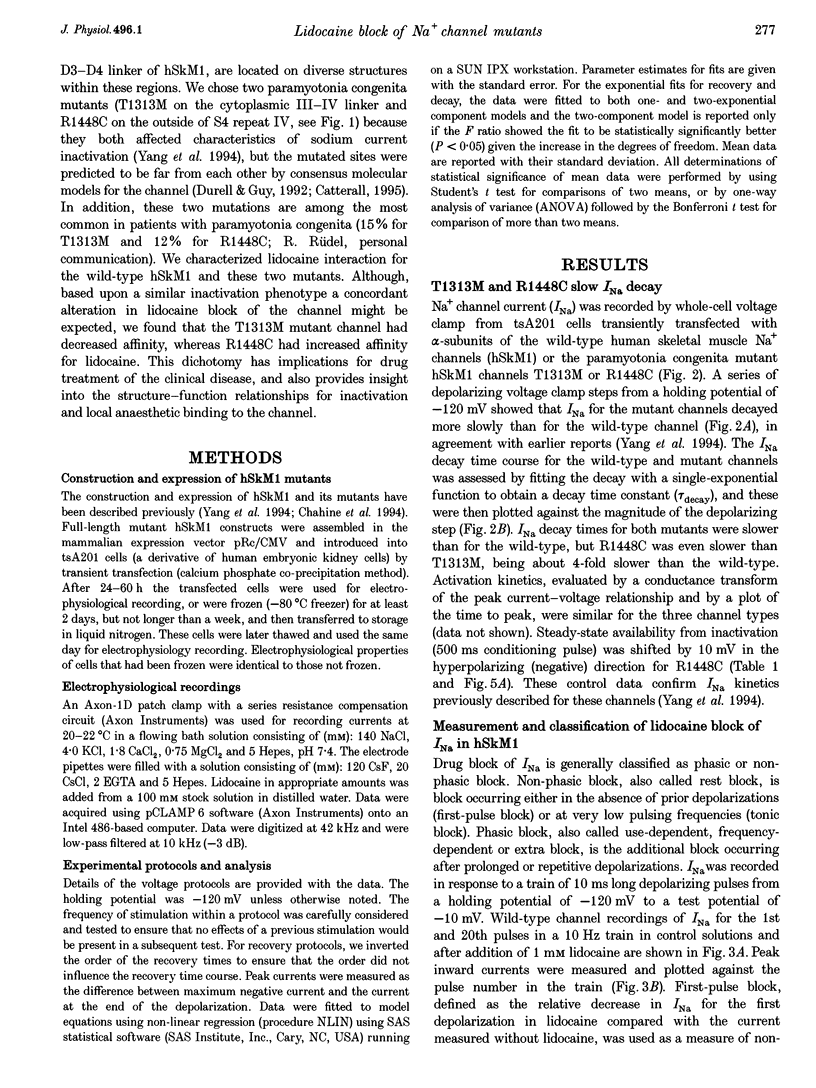
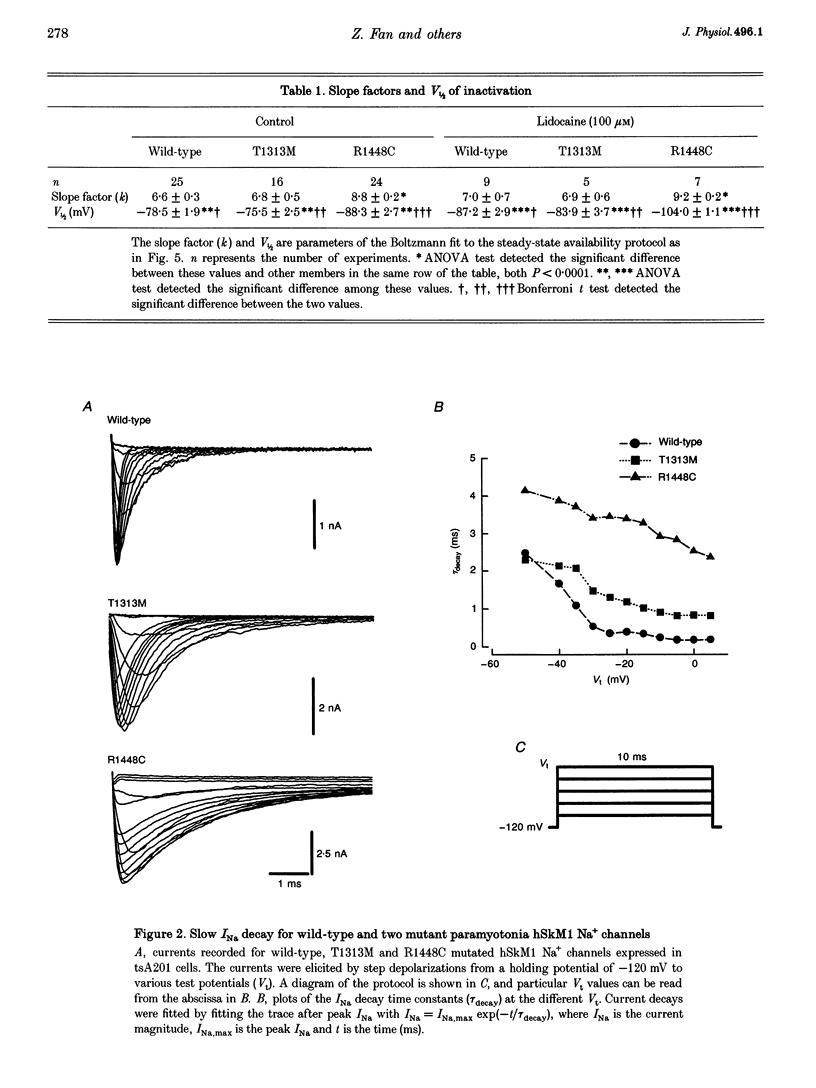
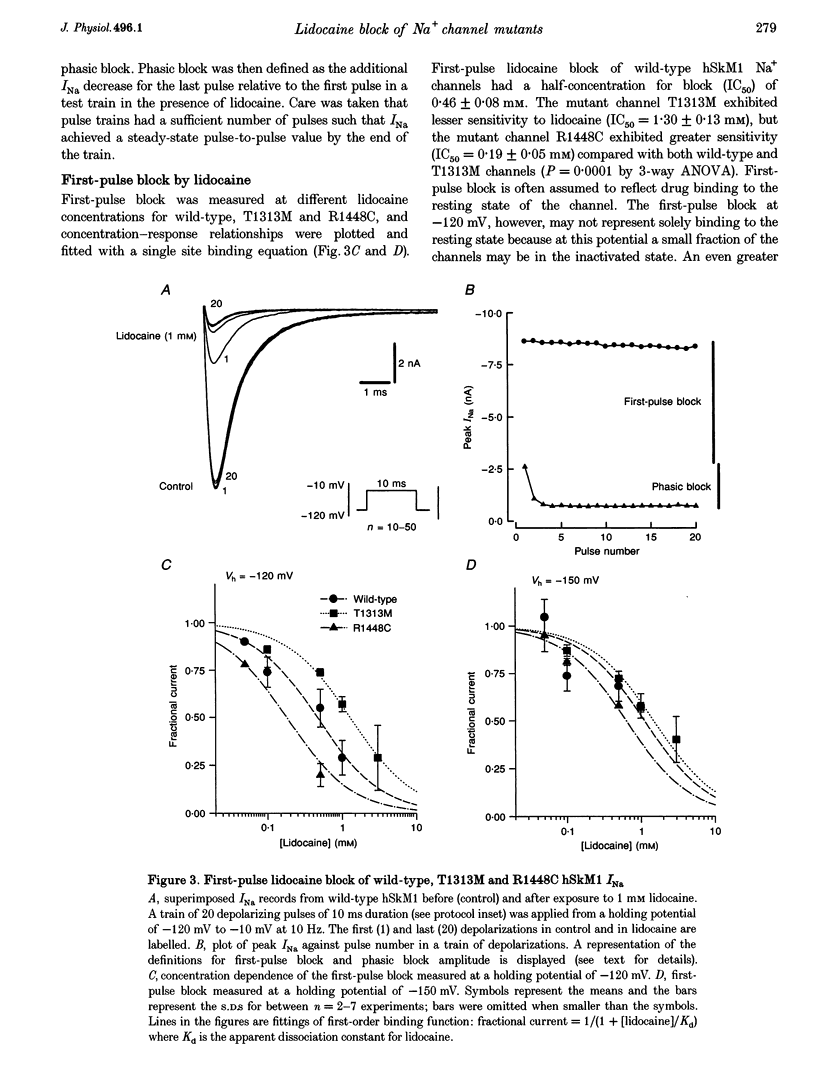
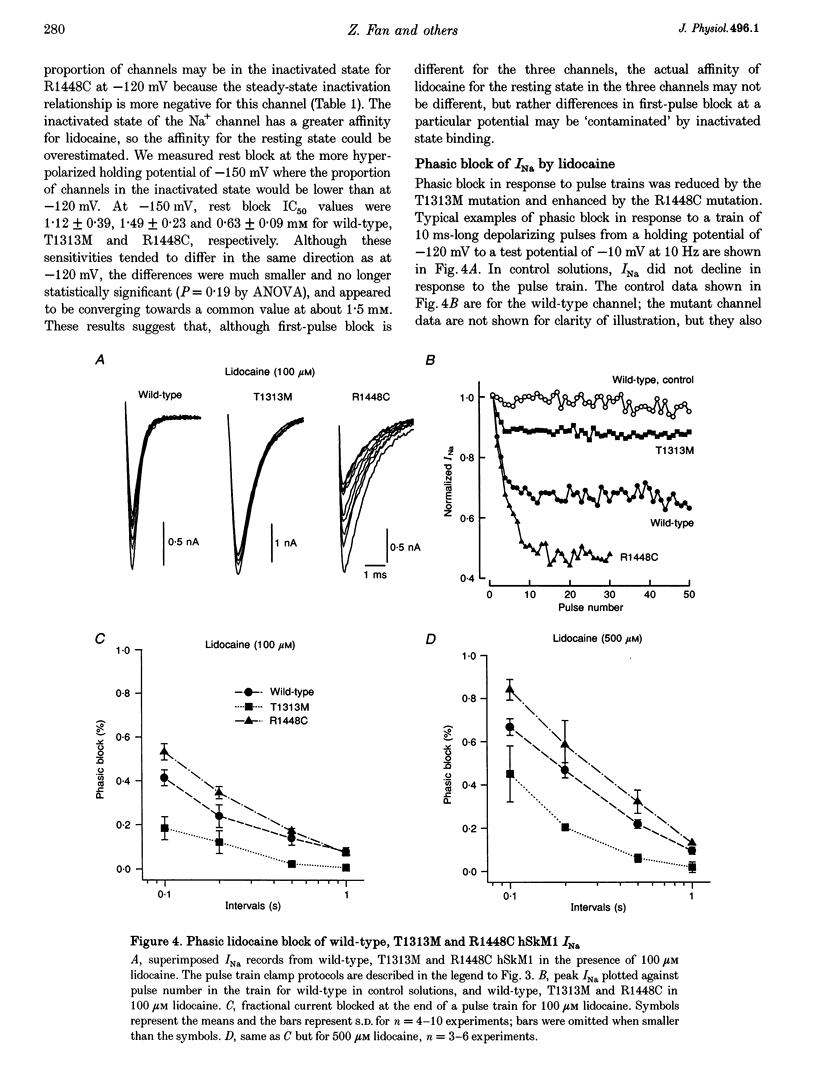
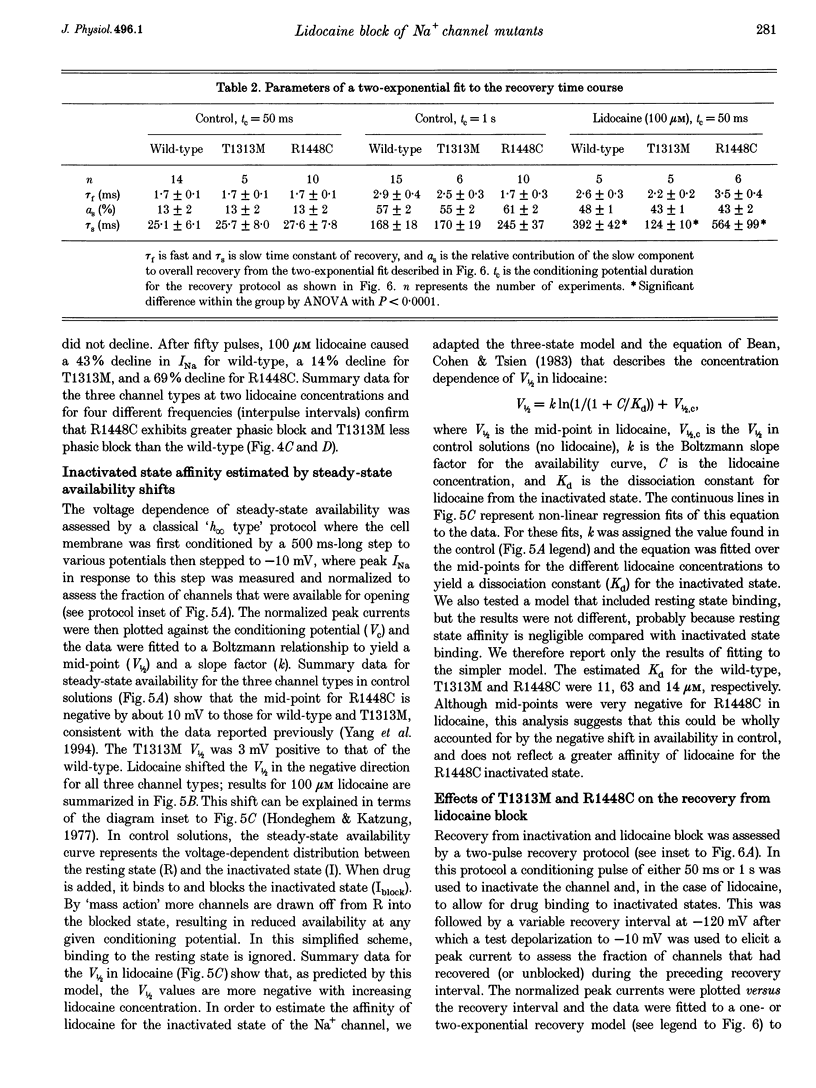

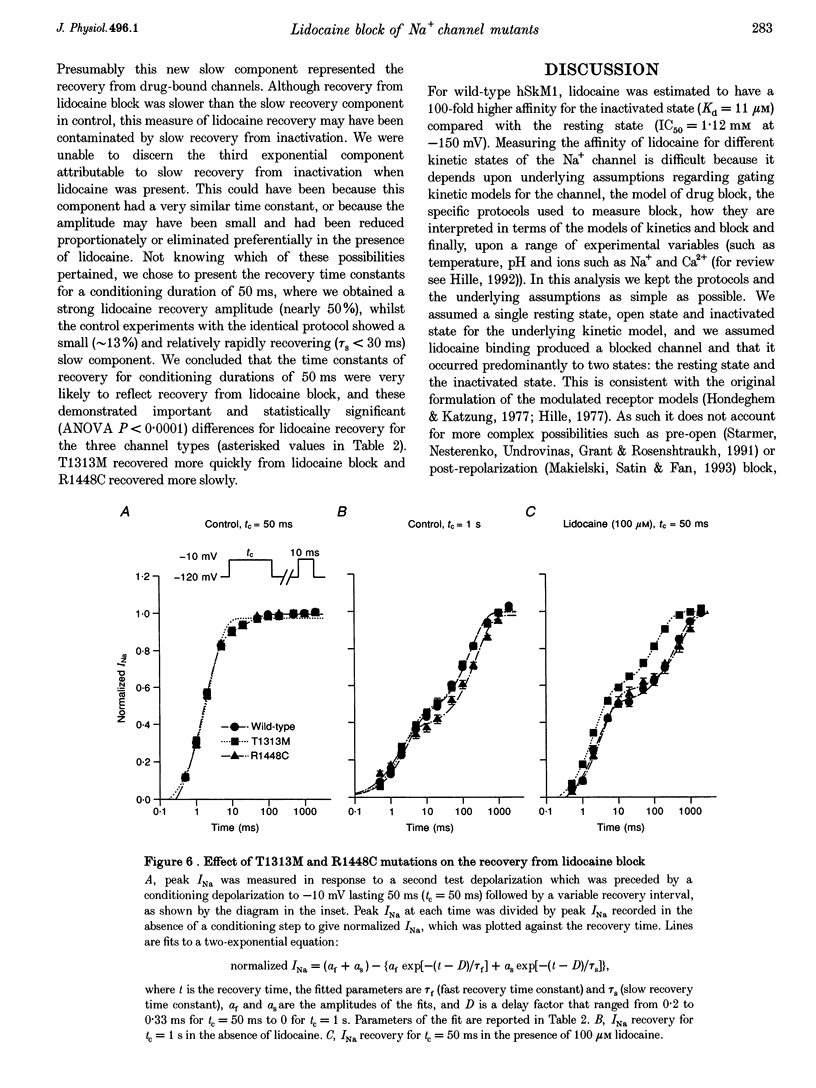
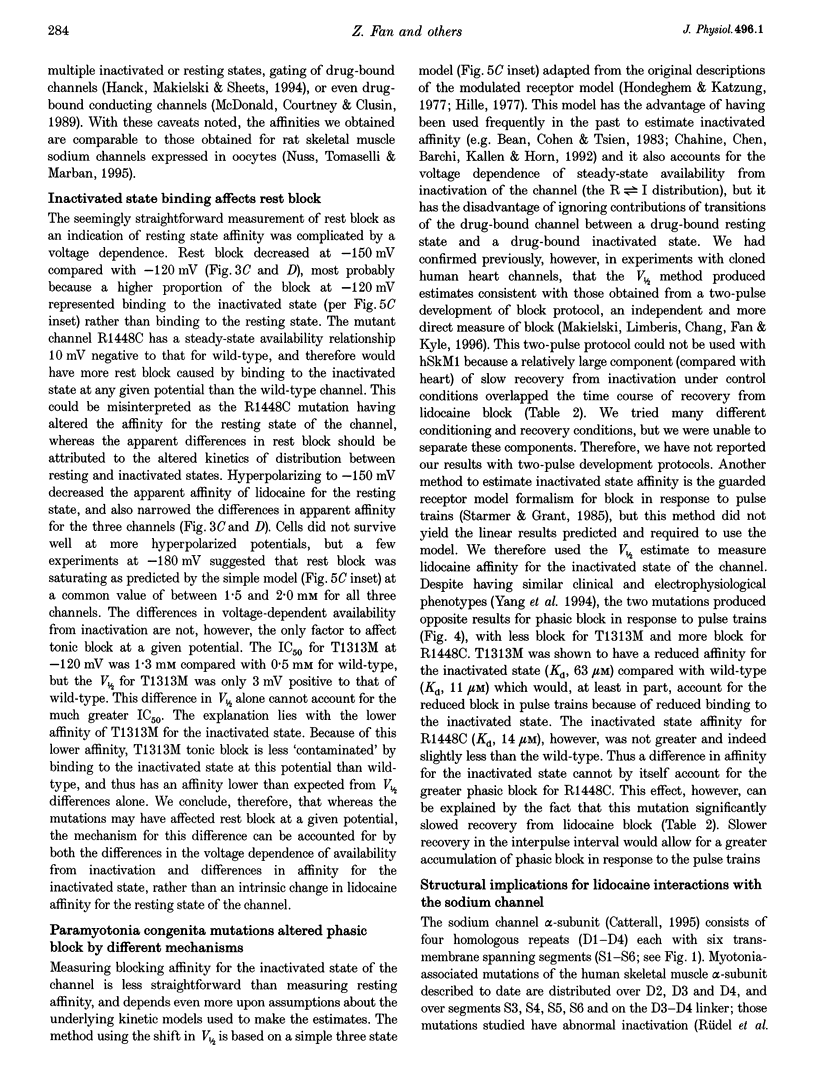
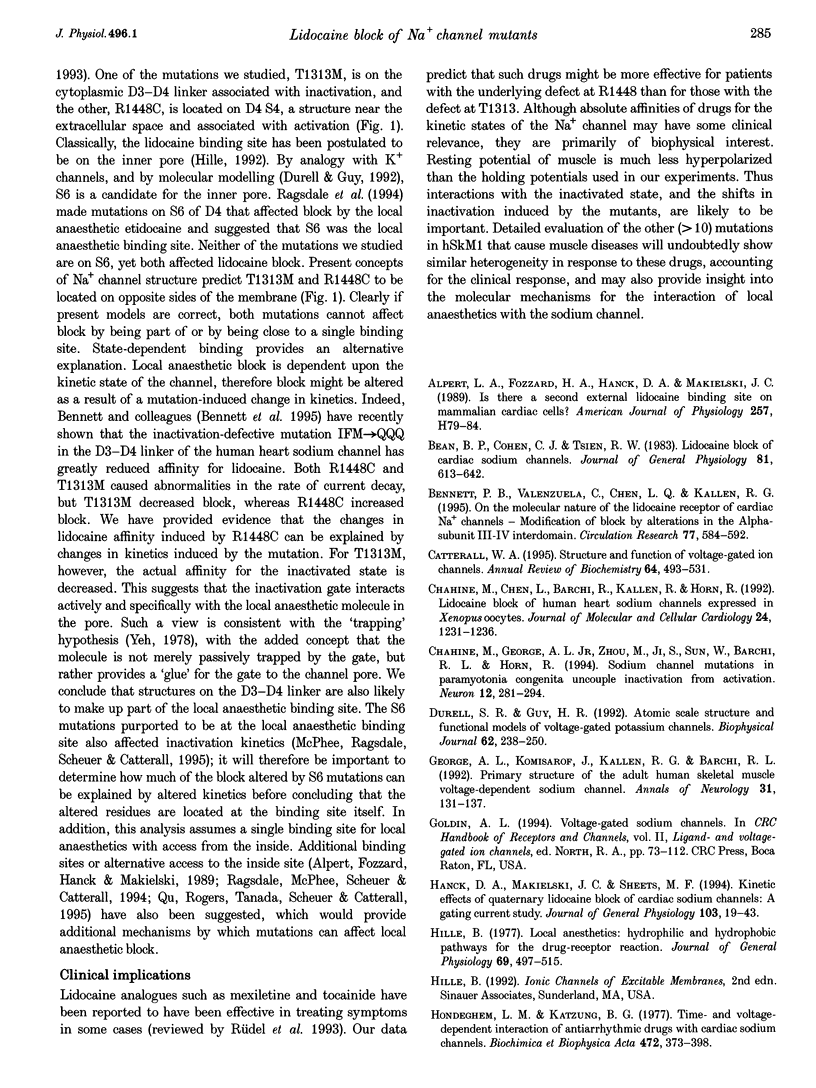
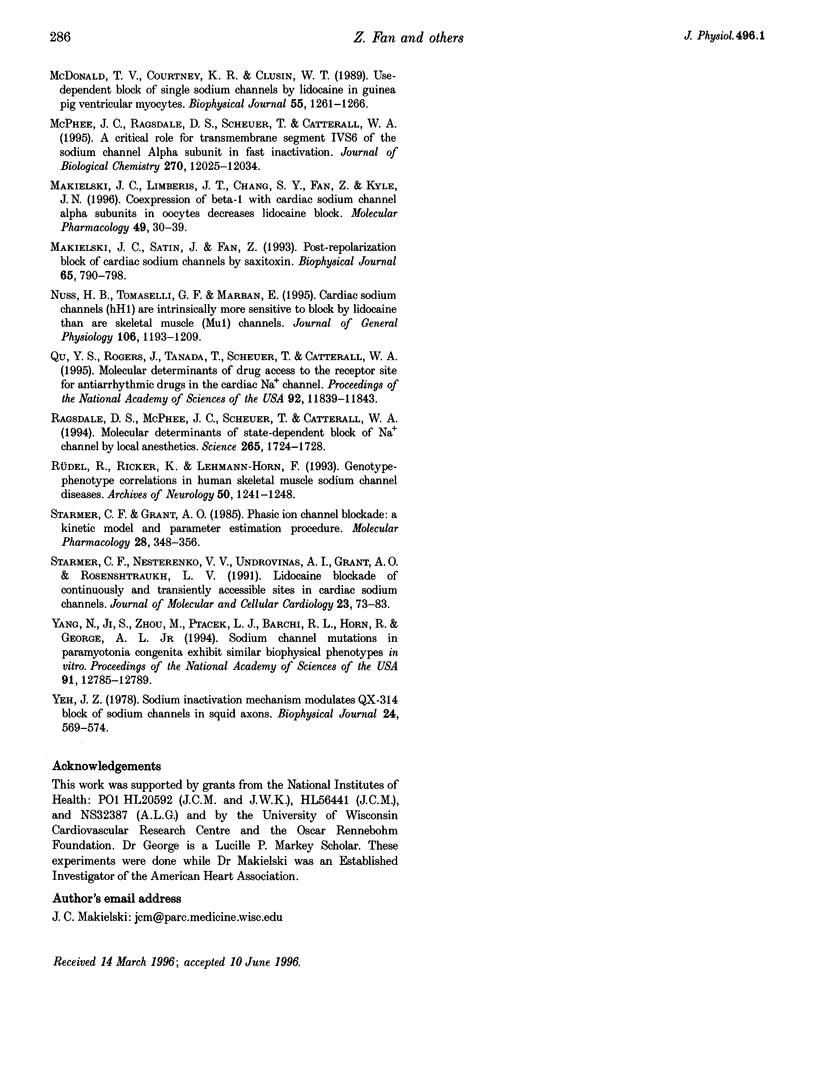
Images in this article
Selected References
These references are in PubMed. This may not be the complete list of references from this article.
- Alpert L. A., Fozzard H. A., Hanck D. A., Makielski J. C. Is there a second external lidocaine binding site on mammalian cardiac cells? Am J Physiol. 1989 Jul;257(1 Pt 2):H79–H84. doi: 10.1152/ajpheart.1989.257.1.H79. [DOI] [PubMed] [Google Scholar]
- Bean B. P., Cohen C. J., Tsien R. W. Lidocaine block of cardiac sodium channels. J Gen Physiol. 1983 May;81(5):613–642. doi: 10.1085/jgp.81.5.613. [DOI] [PMC free article] [PubMed] [Google Scholar]
- Bennett P. B., Valenzuela C., Chen L. Q., Kallen R. G. On the molecular nature of the lidocaine receptor of cardiac Na+ channels. Modification of block by alterations in the alpha-subunit III-IV interdomain. Circ Res. 1995 Sep;77(3):584–592. doi: 10.1161/01.res.77.3.584. [DOI] [PubMed] [Google Scholar]
- Catterall W. A. Structure and function of voltage-gated ion channels. Annu Rev Biochem. 1995;64:493–531. doi: 10.1146/annurev.bi.64.070195.002425. [DOI] [PubMed] [Google Scholar]
- Chahine M., Chen L. Q., Barchi R. L., Kallen R. G., Horn R. Lidocaine block of human heart sodium channels expressed in Xenopus oocytes. J Mol Cell Cardiol. 1992 Nov;24(11):1231–1236. doi: 10.1016/0022-2828(92)93090-7. [DOI] [PubMed] [Google Scholar]
- Chahine M., George A. L., Jr, Zhou M., Ji S., Sun W., Barchi R. L., Horn R. Sodium channel mutations in paramyotonia congenita uncouple inactivation from activation. Neuron. 1994 Feb;12(2):281–294. doi: 10.1016/0896-6273(94)90271-2. [DOI] [PubMed] [Google Scholar]
- Durell S. R., Guy H. R. Atomic scale structure and functional models of voltage-gated potassium channels. Biophys J. 1992 Apr;62(1):238–250. doi: 10.1016/S0006-3495(92)81809-X. [DOI] [PMC free article] [PubMed] [Google Scholar]
- George A. L., Jr, Komisarof J., Kallen R. G., Barchi R. L. Primary structure of the adult human skeletal muscle voltage-dependent sodium channel. Ann Neurol. 1992 Feb;31(2):131–137. doi: 10.1002/ana.410310203. [DOI] [PubMed] [Google Scholar]
- Hanck D. A., Makielski J. C., Sheets M. F. Kinetic effects of quaternary lidocaine block of cardiac sodium channels: a gating current study. J Gen Physiol. 1994 Jan;103(1):19–43. doi: 10.1085/jgp.103.1.19. [DOI] [PMC free article] [PubMed] [Google Scholar]
- Hille B. Local anesthetics: hydrophilic and hydrophobic pathways for the drug-receptor reaction. J Gen Physiol. 1977 Apr;69(4):497–515. doi: 10.1085/jgp.69.4.497. [DOI] [PMC free article] [PubMed] [Google Scholar]
- Hondeghem L. M., Katzung B. G. Time- and voltage-dependent interactions of antiarrhythmic drugs with cardiac sodium channels. Biochim Biophys Acta. 1977 Nov 14;472(3-4):373–398. doi: 10.1016/0304-4157(77)90003-x. [DOI] [PubMed] [Google Scholar]
- Makielski J. C., Limberis J. T., Chang S. Y., Fan Z., Kyle J. W. Coexpression of beta 1 with cardiac sodium channel alpha subunits in oocytes decreases lidocaine block. Mol Pharmacol. 1996 Jan;49(1):30–39. [PubMed] [Google Scholar]
- Makielski J. C., Satin J., Fan Z. Post-repolarization block of cardiac sodium channels by saxitoxin. Biophys J. 1993 Aug;65(2):790–798. doi: 10.1016/S0006-3495(93)81102-0. [DOI] [PMC free article] [PubMed] [Google Scholar]
- McDonald T. V., Courtney K. R., Clusin W. T. Use-dependent block of single sodium channels by lidocaine in guinea pig ventricular myocytes. Biophys J. 1989 Jun;55(6):1261–1266. doi: 10.1016/S0006-3495(89)82921-2. [DOI] [PMC free article] [PubMed] [Google Scholar]
- McPhee J. C., Ragsdale D. S., Scheuer T., Catterall W. A. A critical role for transmembrane segment IVS6 of the sodium channel alpha subunit in fast inactivation. J Biol Chem. 1995 May 19;270(20):12025–12034. doi: 10.1074/jbc.270.20.12025. [DOI] [PubMed] [Google Scholar]
- Nuss H. B., Tomaselli G. F., Marbán E. Cardiac sodium channels (hH1) are intrinsically more sensitive to block by lidocaine than are skeletal muscle (mu 1) channels. J Gen Physiol. 1995 Dec;106(6):1193–1209. doi: 10.1085/jgp.106.6.1193. [DOI] [PMC free article] [PubMed] [Google Scholar]
- Qu Y., Rogers J., Tanada T., Scheuer T., Catterall W. A. Molecular determinants of drug access to the receptor site for antiarrhythmic drugs in the cardiac Na+ channel. Proc Natl Acad Sci U S A. 1995 Dec 5;92(25):11839–11843. doi: 10.1073/pnas.92.25.11839. [DOI] [PMC free article] [PubMed] [Google Scholar]
- Ragsdale D. S., McPhee J. C., Scheuer T., Catterall W. A. Molecular determinants of state-dependent block of Na+ channels by local anesthetics. Science. 1994 Sep 16;265(5179):1724–1728. doi: 10.1126/science.8085162. [DOI] [PubMed] [Google Scholar]
- Rüdel R., Ricker K., Lehmann-Horn F. Genotype-phenotype correlations in human skeletal muscle sodium channel diseases. Arch Neurol. 1993 Nov;50(11):1241–1248. doi: 10.1001/archneur.1993.00540110113011. [DOI] [PubMed] [Google Scholar]
- Starmer C. F., Grant A. O. Phasic ion channel blockade. A kinetic model and parameter estimation procedure. Mol Pharmacol. 1985 Oct;28(4):348–356. [PubMed] [Google Scholar]
- Starmer C. F., Nesterenko V. V., Undrovinas A. I., Grant A. O., Rosenshtraukh L. V. Lidocaine blockade of continuously and transiently accessible sites in cardiac sodium channels. J Mol Cell Cardiol. 1991 Feb;23 (Suppl 1):73–83. doi: 10.1016/0022-2828(91)90026-i. [DOI] [PubMed] [Google Scholar]
- Yang N., Ji S., Zhou M., Ptácek L. J., Barchi R. L., Horn R., George A. L., Jr Sodium channel mutations in paramyotonia congenita exhibit similar biophysical phenotypes in vitro. Proc Natl Acad Sci U S A. 1994 Dec 20;91(26):12785–12789. doi: 10.1073/pnas.91.26.12785. [DOI] [PMC free article] [PubMed] [Google Scholar]
- Yeh J. Z. Sodium inactivation mechanism modulates QX-314 block of sodium channels in squid axons. Biophys J. 1978 Nov;24(2):569–574. doi: 10.1016/S0006-3495(78)85403-4. [DOI] [PMC free article] [PubMed] [Google Scholar]



